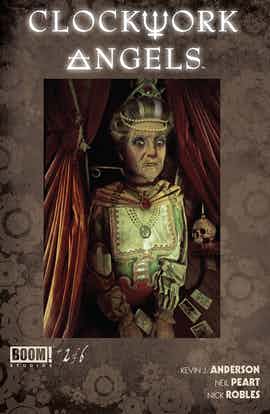
Despite consistently beautiful artwork from Nick Robles, the second issue of “Clockwork Angels” doesn’t live up to the first. Kevin J. Anderson’s plot falls into a listless, anchorless pace as Owen Hardy wanders through Crown City, and it just couldn’t keep my interest. In principle, an issue that explores this fascinating city would be a lovely second-act break, but absent any wonder or stakes for the reader, it drags.
Crown City is undoubtedly a handsome city to look at. Spilling over with inventions, clocks and period clothing, it’s a markedly steampunk place, but Robles’ take on “steampunk” is unexpected and eye-catching. Many artists approach steampunk from a dirty, industrial perspective, all heaving machines and billows of smoke. Robles’ approach is refreshingly soft, combining the nostalgic pastoralism of pre-industrial Britain with the warm shine of clean-looking, post-industrial technology. The sky is forever light blue with tufty clouds, the city is always bathed in yellow light, and everything has the soft edges and dappled shading of an oil painting. Not only is it lovely, but it allows the reader to see Crown City through Owen’s rose-colored glasses. This really looks like a utopia.
Unfortunately, the story is in this issue is dry and meandering. Owen explores the city for the first time, and he’s enamored. “I’m lost inside a treasure chest of wonderful things,” he thinks, “…Everything is incredible!” However, Owen is a country boy in a tightly controlled, repressive dictatorship, and what is fascinating to him is not necessarily so for the reader. There are some exceptions when Anderson shows rather than tells. The scene with the percussor is fun and expertly executed, and Francesca’s flight in the carnival is a graceful surprise.
However, there are so many of these scenes of exploration, and not all of them hit. I don’t need all of them to be entrancing, but those that are not simply there for enjoyment should be meaningful. The scenes on the ship, or when Owen goes to look at the universe, for example, are neither, and as a result they feel much longer than they are. Many of the elements of Crown City that Anderson takes the time to establish have already been established, and the page space could have been better spent on showing the reader something new.
The same is true for the scenes with the Anarchist and Watchmaker. Though it’s smart that Anderson has already introduced these two, there is no sense yet of how either is moving toward his ultimate end. Their scenes feel disparate, like a series of slice-of-life scenes, each of which emphasizes the same point about their characters. The Watchmaker values order; the Anarchist loathes it. Without specific projects to illustrate these goals, their storylines don’t build.
“Clockwork Angels” remains a fascinating project with a charming aesthetic, but it needs a firmer grip on its plot. Right now, I can’t determine what drives the story from one scene to the next, other than mechanics. Until it’s clearer what the creative team wants to accomplish, my appreciation for the series may remain aesthetic.

